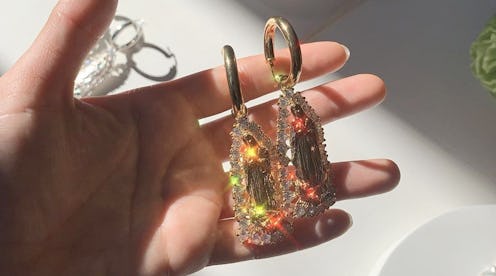(Fashion)
Small Batch Is The Future Of Sustainable Jewelry

If you've ever Googled what a landfill actually looks like, you'll know that it's a bleak snapshot of discarded, forgotten items piled high. It's a depressing image, but also serves as a reminder that cutting down on waste is a key pillar to reducing your impact on the planet. From a purchasing standpoint it means buying fewer, better things. So what should you look out for when shopping? In production, ideas like small batch jewelry and made-to-order jewelry are modest but meaningful paths to moving toward a less-waste approach to fashion. They also happen to be getting more popular.
"We don't want to contribute excess, therefore we always debut our collections with a limited quantity and then work to reproduce each piece on a nearly made-to-order basis," Jennifer Paccione Angulo tells TZR. She's the founder and creative director of Mediterraneo, a Southern Italian-inspired jewelry brand that's known for its Instagram-friendly solid gold pieces, like the Peperoncini earrings and necklace. "Since we keep limited quantities on-hand at a time, we never have excess product at the end of a season, which means we never go on sale in the hopes of getting rid of leftover pieces."
Designer Jean Prounis opts for a handmade-to-order system with her namesake jewelry brand, Prounis. The pieces are crafted from recycled gold and gemstones are hand-selected in small quantities.
"We recycle our scrap gold from one piece to use towards the next piece and it is a continuous cycle," she says. "When we need to invest in more raw materials, we purchase refined gold that is largely recycled post-consumer gold pieces and studio 'sweeps' which we then alloy in our studio according to our orders." Prounis cites slowing down and practicing more mindful, calculated production as a driving force in her business.
"Our slower approach to production really allows us to control our ecological footprint and create jewelry with purpose," she adds.
For the consumer, there are added emotional benefits of small-batch and made-to-order jewelry over large-scale production. For starters, it promotes longevity. Investing in brands that work on a slower cycle usually results in a better product that you can wear for longer. "All of our pieces are solid gold but at a direct-to-consumer price point," Angulo says. "Consumers have more approachable accessibility to higher quality jewelry and they can wear it longer. No tarnishing, corroding, or allergies ... therefore just simply buy less."
It also brings into focus an appreciation of the technique and materials. Sophie Ratner follows a similar process for her jewelry brand, carrying no inventory and designing each piece after it's ordered. "Most of our work is made in-house. All design, soldering, and cleaning of castings," she shares. "To the extent we use outside contractors, they are small-scale local artisans ... casters, stone setters, and polishers." Mediterraneo also collaborates with artisans, most of whom are based in Southern Italy, Cannes, and New York City.
On the materials side, Jean Prounis shares that this slower pace opens the doors for a more creative process. "We never purchase stones in mass quantities as I firmly believe there is a true romance in working with unique stones," she says. "Stone sourcing is such a rewarding part of this industry, I love taking the time to look at the unique characteristics in each gem we purchase, inclusions and all."
Ahead, find a few more jewelry designers following this production model. Now you can shop the pieces you love for a more environmentally-minded approach to accessorizing.
This article was originally published on